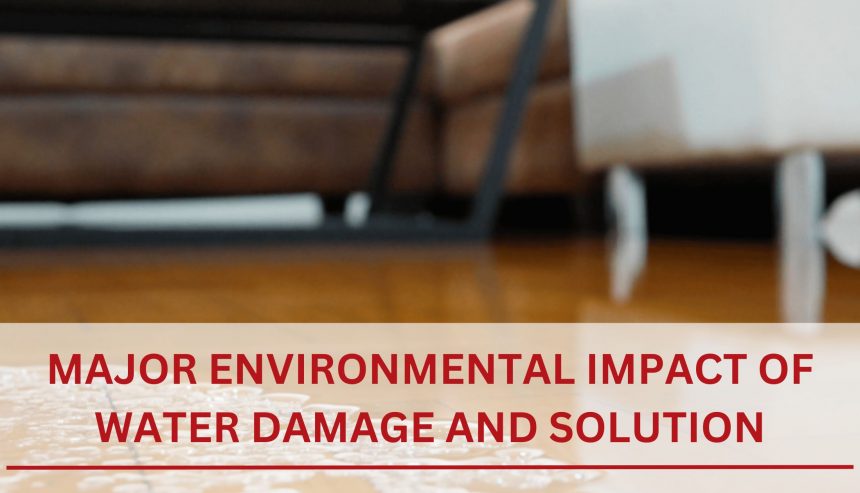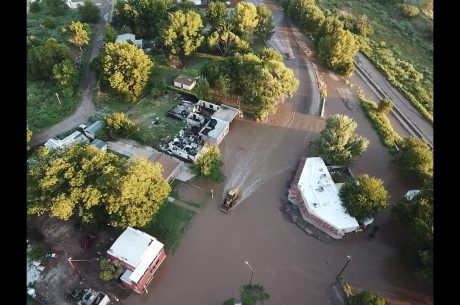Welcome to our latest blog post, where we delve into the crucial topic of environmental impact of water damage and its solutions. As seasoned restoration professionals, we understand the profound ramifications that water damage can have on both the built environment and the delicate ecosystems that surround us.
Beyond the immediate visible damage, water intrusion can trigger a cascade of environmental consequences that reverberate throughout our natural world.
In this exploration, we’ll uncover the major environmental consequences of water damage, shedding light on the intricate web of effects that ripple far beyond the visible surface. Join us as we navigate through the impact of water damage on our immediate and also seek sustainable solutions to mitigate the damage caused by this pervasive threat.
10 Environmental Impacts Of Water Damage
1. Soil Contamination and Erosion:
Floodwaters laden with pollutants can infiltrate the soil, compromising its fertility and structure. Chemicals, sewage, and debris disrupt the delicate balance of nutrients, while erosion exacerbates soil loss, posing a threat to ecosystem stability. Our restoration approach prioritizes eco-friendly methods that minimize soil disturbance and prevent further contamination, safeguarding the integrity of the land.
2. Water Quality Degradation:
Contaminated water stemming from floods or leaks not only endangers aquatic life but also jeopardizes the health of entire communities reliant on these water sources. Our environmentally conscious restoration endeavors focus on thorough cleaning and the removal of contaminants to prevent ongoing pollution, ensuring the preservation of water quality for generations to come.
3. Impact on Flora and Fauna:
Adjacent ecosystems suffer as plants and wildlife grapple with habitat loss, altered water quality, and disrupted natural processes. Recognizing the interconnectedness of all life forms, our restoration efforts aim to restore ecological balance, providing support for the diverse array of species that call these environments home.
4. Energy Consumption in Restoration:
Conventional restoration practices often come with a hefty energy price tag, contributing to carbon emissions and environmental strain. By embracing energy-efficient approaches, such as sustainable materials and green technologies, we minimize our carbon footprint and pave the way for a more sustainable future.
5. Preservation of Wetlands and Natural Habitats:
Wetlands and natural habitats play a crucial role in biodiversity conservation, yet they are particularly vulnerable to water damage. Our restoration endeavors emphasize the preservation of these invaluable ecosystems, striving to restore them to their pre-damaged state and safeguard the unique flora and fauna they harbor.
6. Waste Generation and Disposal:
The restoration process inevitably generates waste, including damaged materials and debris. To mitigate environmental impact, we advocate for responsible waste management practices, promoting recycling, repurposing, and proper disposal methods to minimize our ecological footprint.
7. Sustainable Building Practices:
Incorporating sustainable and resilient building practices is key to mitigating the risk of future water damage. From eco-friendly materials to water-resistant designs, our restoration projects prioritize long-term sustainability, ensuring structures are built to withstand environmental challenges.
8. Community Education and Involvement:
Fostering environmental awareness and engaging local communities are integral aspects of our restoration approach. By empowering individuals with knowledge about the environmental impact of water damage, we cultivate a sense of responsibility and promote sustainable practices to prevent and address such incidents effectively.
9. Impact on Air Quality:
Mold growth resulting from water damage poses not only health risks for occupants but also environmental concerns. Thorough mold removal is paramount to ensuring healthier indoor air and mitigating broader implications for the surrounding ecosystem.
10. Disruption of Aquatic Ecosystems:
Beyond water quality degradation, water damage disrupts aquatic ecosystems by altering vital parameters such as temperature, flow patterns, and nutrient levels. Our restoration efforts take into account the intricate relationships within these ecosystems, striving to restore natural balance and support aquatic life.
Solutions to the Environmental Impact Of Water Damage
Addressing the environmental impact of water damage requires a multifaceted approach that encompasses both preventive measures and proactive restoration strategies.

Here are some key solutions:
Preventive Measures:
- Implementing proper drainage systems, flood barriers, and waterproofing techniques to reduce the risk of water damage.
- Regular maintenance of plumbing, roofing, and infrastructure to identify and address potential leaks or weak points before they escalate.
- Land use planning and zoning regulations to minimize development in flood-prone areas and protect natural waterways and wetlands.
Immediate Response:
- Swift action to remove standing water and dry affected areas to prevent further damage and mold growth.
- Utilizing eco-friendly cleaning agents and methods to minimize the introduction of harmful chemicals into the environment.
- Proper disposal of contaminated materials and waste in accordance with environmental regulations.
Eco-Friendly Restoration Practices:
- Employing sustainable building materials and techniques that reduce energy consumption and minimize environmental impact.
- Prioritizing native vegetation and habitat restoration to support biodiversity and ecosystem resilience.
- Integrating green technologies, such as renewable energy sources and energy-efficient appliances, into restoration projects to reduce carbon emissions and promote sustainability.
Community Engagement and Education:
- Raising awareness about the environmental impact of water damage and the importance of preventive measures through community outreach and education programs.
- Encouraging community involvement in restoration efforts, such as volunteering for clean-up initiatives or participating in habitat restoration projects.
- Collaborating with local authorities, environmental organizations, and stakeholders to develop and implement comprehensive water management plans that prioritize environmental conservation.
Policy and Regulation:
- Enacting and enforcing policies and regulations that promote sustainable land use practices, water conservation, and responsible waste management.
- Providing incentives for businesses and homeowners to invest in eco-friendly infrastructure and practices, such as rainwater harvesting systems or green roofs.
- Supporting research and development initiatives aimed at finding innovative solutions to mitigate the environmental impact of water damage and enhance resilience to future water-related disasters.
By integrating these solutions into our approach to water damage management and restoration, we can minimize environmental harm, protect natural ecosystems, and build more resilient communities capable of weathering the challenges of a changing climate.
Also, by embracing these principles and adopting eco-friendly practices, Water Damage Restoration professionals like us demonstrates its unwavering commitment to restoring not just structures, but the delicate balance of our natural world. Together, let’s pave the way for a more sustainable future, one restoration project at a time.
In conclusion, the environmental impact of water damage extends far beyond the visible damage to structures. It disrupts ecosystems, threatens biodiversity, and compromises the health of communities and habitats alike. As restoration professionals, it’s our responsibility to address these challenges with diligence and foresight, prioritizing eco-conscious solutions that mitigate further harm and promote long-term sustainability.
As we navigate the complexities of water damage restoration, let us remain steadfast in our commitment to environmental stewardship. Together, we can turn the tide on water damage, preserving the beauty and integrity of our natural world for generations to come.




 PuroClean Emergency Fire, Water and Mold Damage Restoration New Jersey
PuroClean Emergency Fire, Water and Mold Damage Restoration New Jersey